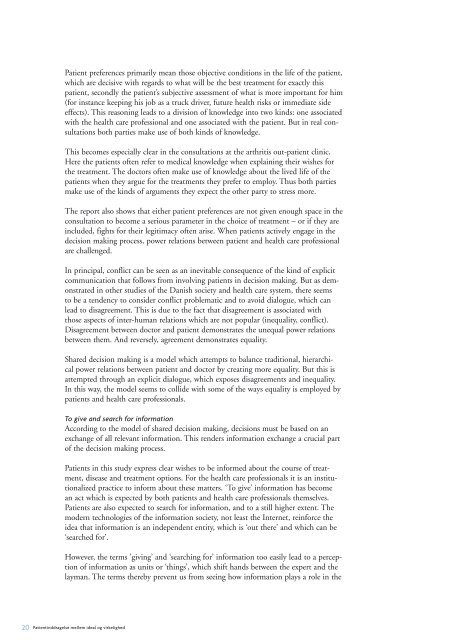Patientinddragelse mellem ideal og virkelighed - Sundhedsstyrelsen
Patientinddragelse mellem ideal og virkelighed - Sundhedsstyrelsen
Patientinddragelse mellem ideal og virkelighed - Sundhedsstyrelsen
You also want an ePaper? Increase the reach of your titles
YUMPU automatically turns print PDFs into web optimized ePapers that Google loves.
Patient preferences primarily mean those objective conditions in the life of the patient,<br />
which are decisive with regards to what will be the best treatment for exactly this<br />
patient, secondly the patient’s subjective assessment of what is more important for him<br />
(for instance keeping his job as a truck driver, future health risks or immediate side<br />
effects). This reasoning leads to a division of knowledge into two kinds: one associated<br />
with the health care professional and one associated with the patient. But in real consultations<br />
both parties make use of both kinds of knowledge.<br />
This becomes especially clear in the consultations at the arthritis out-patient clinic.<br />
Here the patients often refer to medical knowledge when explaining their wishes for<br />
the treatment. The doctors often make use of knowledge about the lived life of the<br />
patients when they argue for the treatments they prefer to employ. Thus both parties<br />
make use of the kinds of arguments they expect the other party to stress more.<br />
The report also shows that either patient preferences are not given enough space in the<br />
consultation to become a serious parameter in the choice of treatment – or if they are<br />
included, fights for their legitimacy often arise. When patients actively engage in the<br />
decision making process, power relations between patient and health care professional<br />
are challenged.<br />
In principal, conflict can be seen as an inevitable consequence of the kind of explicit<br />
communication that follows from involving patients in decision making. But as demonstrated<br />
in other studies of the Danish society and health care system, there seems<br />
to be a tendency to consider conflict problematic and to avoid dial<strong>og</strong>ue, which can<br />
lead to disagreement. This is due to the fact that disagreement is associated with<br />
those aspects of inter-human relations which are not popular (inequality, conflict).<br />
Disagreement between doctor and patient demonstrates the unequal power relations<br />
between them. And reversely, agreement demonstrates equality.<br />
Shared decision making is a model which attempts to balance traditional, hierarchical<br />
power relations between patient and doctor by creating more equality. But this is<br />
attempted through an explicit dial<strong>og</strong>ue, which exposes disagreements and inequality.<br />
In this way, the model seems to collide with some of the ways equality is employed by<br />
patients and health care professionals.<br />
To give and search for information<br />
According to the model of shared decision making, decisions must be based on an<br />
exchange of all relevant information. This renders information exchange a crucial part<br />
of the decision making process.<br />
Patients in this study express clear wishes to be informed about the course of treatment,<br />
disease and treatment options. For the health care professionals it is an institutionalized<br />
practice to inform about these matters. ‘To give’ information has become<br />
an act which is expected by both patients and health care professionals themselves.<br />
Patients are also expected to search for information, and to a still higher extent. The<br />
modern technol<strong>og</strong>ies of the information society, not least the Internet, reinforce the<br />
idea that information is an independent entity, which is ‘out there’ and which can be<br />
‘searched for’.<br />
However, the terms ’giving’ and ‘searching for’ information too easily lead to a perception<br />
of information as units or ‘things’, which shift hands between the expert and the<br />
layman. The terms thereby prevent us from seeing how information plays a role in the<br />
20 <strong>Patientinddragelse</strong> <strong>mellem</strong> <strong>ideal</strong> <strong>og</strong> <strong>virkelighed</strong>

















